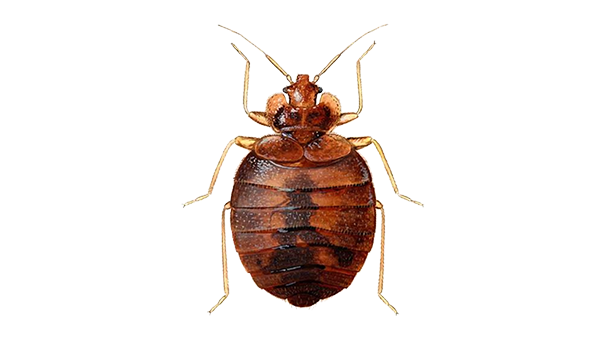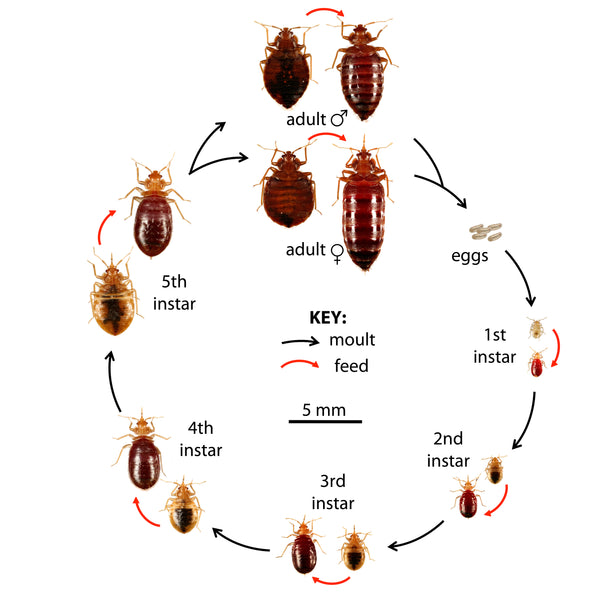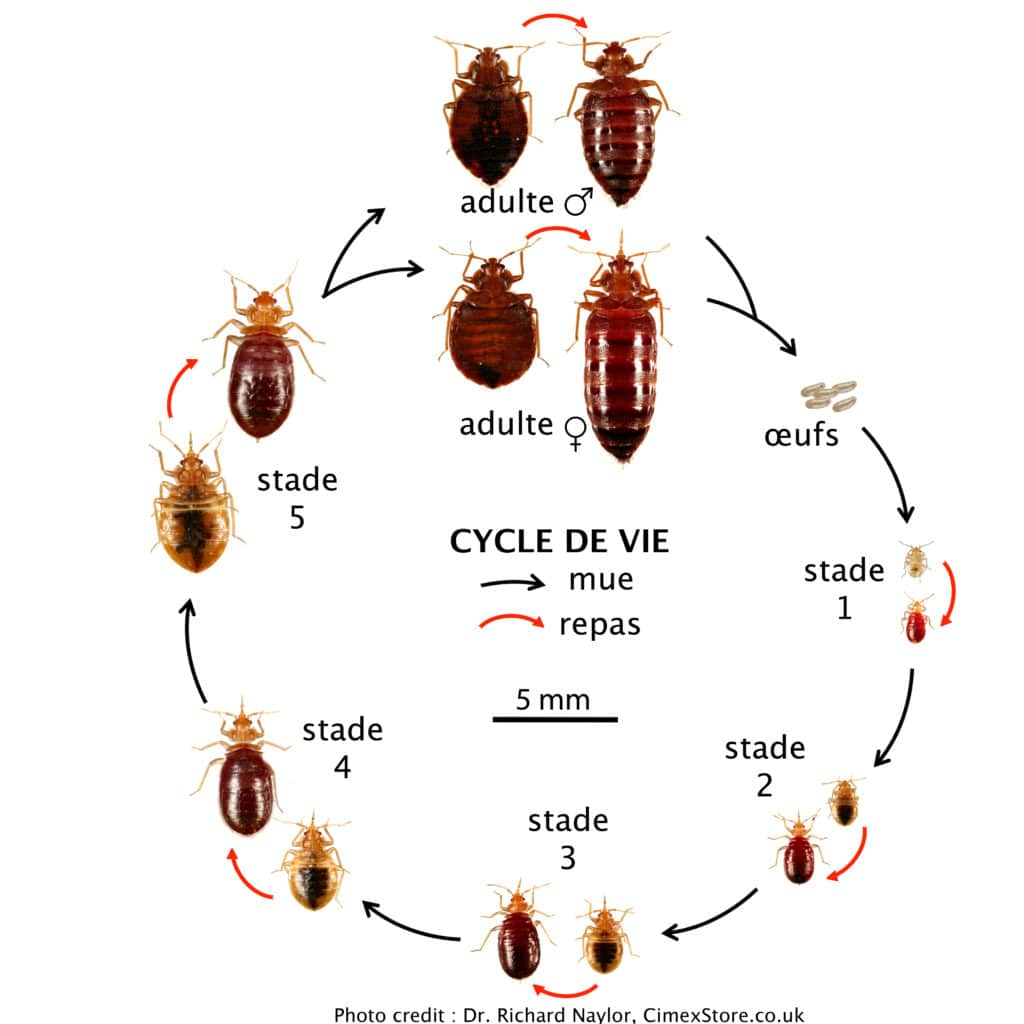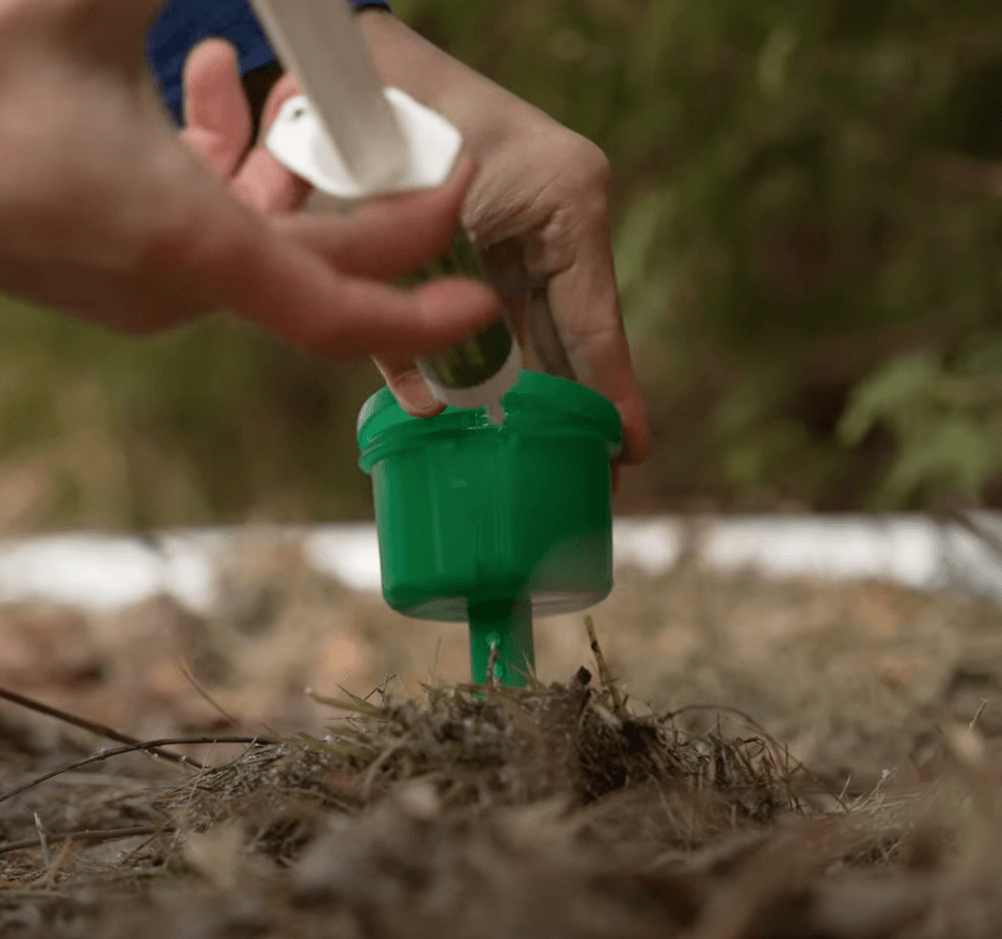
Signs of presence ⌵

General description ⌵

How to get rid of it ⌵

Dangers and damages ⌵
Signs of Bed Bugs
Bed bugs are small and hard to spot, leaving behind various signs of an infestation. Here are the main clues to identify their presence.
1. Blood stains and marks on sheets
One of the most identifiable signs is the presence of small blood spots on sheets, mattresses or pillows. These spots, often red in color, appear when a crushed bedbug releases digested blood after feeding. They are particularly visible in the morning on light-colored sheets, revealing the bedbugs' nocturnal activity.
2. Droppings in the form of dark spots
Bed bugs also leave droppings in the form of tiny black or brown spots on surfaces near their habitat, such as mattress seams, bed frames, furniture and walls. These marks, which look like small pencil marks, are actually residue from digested blood and accumulate in areas where the bugs frequent.
3. Molted skins and exoskeletons
Bed bugs go through several stages of development, shedding their skin at each stage. The transparent, yellowish exoskeletons can be found in the nooks and crannies of mattresses, box springs, and around furniture. These sheddings are a clear sign of an active infestation, especially if they multiply in areas where humans sleep.
4. Eggs and eggshells
Bed bug eggs are tiny, pearly white, and about 1 mm in size, resembling small grains of rice. They are often found in clusters in mattress seams, wall cracks, or upholstered furniture. These sticky eggs attach themselves to surfaces, making them difficult to eliminate.
5. Mold smell
When an infestation is heavy, it can emit a musty odor, sometimes reminiscent of damp laundry. This odor comes from the pheromones released by bedbugs when they gather in large groups, and it is often detectable near their hiding places, such as in bedrooms or living rooms.
General Description of Bed Bugs
Bed bugs, mainly Cimex lectularius , are small parasitic insects known for their ability to infest areas where humans sleep and spend most of their time. They are 4 to 5 mm long, about the size of an apple seed, and have a flat, reddish-brown body that becomes more swollen and reddish after a blood meal. Bed bugs feed exclusively on blood and prefer to feed on humans, but they can also bite pets.
These pests hide in the folds of mattresses, the cracks in beds, and even behind loose wallpaper, where they remain inconspicuous during the day and emerge at night to feed. Their nocturnal lifestyle makes them difficult to detect, and they often leave indirect traces, such as small dark spots of blood or exoskeletons left behind after they shed their skin. Bed bugs are resilient and can survive for months without feeding, allowing them to persist in a space even when humans are absent for a period of time.
The bed bug life cycle consists of several stages: egg, five nymph stages, and then adult. The eggs, white and almost microscopic, are laid in small clusters and hatch in about a week. Each nymph stage requires a blood meal to evolve into the adult stage. These insects can quickly spread from one place to another via clothing, luggage, or even second-hand furniture, thus promoting their spread in hotels, residences, and public transportation.
How to Get Rid of Bed Bugs?
Bed bugs are a major problem that can seriously disrupt your quality of life. These pests, often hiding in the dark corners of your mattress, furniture and clothing, feed on human blood, mainly at night. If you suspect a bed bug infestation, it is crucial to act quickly to prevent them from spreading and making eradication more difficult.
1. Identify the Signs of an Infestation
Before starting any treatment, it is essential to confirm the presence of bedbugs. In order to spot them, you must look for the following signs in suitable places, such as in the seams of your mattress, the cracks in your bed base (especially if it is made of wood) and others:
- Visible bugs : Adults are small, reddish-brown and oval in shape, about the size of an apple seed.
- Exoskeletons : Bed bugs shed their skin as they grow, leaving behind empty exoskeletons.
- Blood Stains and Feces : Black or brown stains on your sheets or mattress may indicate the presence of these pests.
2. Contain and Prevent the Spread
To prevent bedbugs from spreading throughout your home, limit their movement by:
- Using anti-bedbug mattress and box spring covers . However, it is important to remove these during treatment in order to treat the bed and its base to prevent live bedbugs from remaining hidden inside the cover.
- Avoid moving infested objects to other rooms.
3. Preparation for Treatment
Before proceeding with the eradication, prepare the affected area:
- Get Rid of Clutter : Thoroughly clean and organize infested areas.
- Wash contaminated items : Clothing, bedding and covers should be washed in hot water (at least 50°C) and dried at a high temperature to kill bedbugs and their eggs.
- Consider steam cleaning furniture and carpets, as steam kills bedbugs at temperatures above 50°C.
4. Methods of Eradication
There are several methods to eradicate bed bugs, including:
- Heat treatments : Heat infested objects above 50°C.
- Vacuuming : Vacuum mattresses, furniture and carpets regularly. Be sure to immediately dispose of the vacuum bag in a sealed bag.
- Pesticide use : Pyrethroid insecticides are often used, but their application must be precise, targeting cracks and crevices where bedbugs hide.
5. Monitoring and Prevention
After treatment, it is important to:
- Inspect regularly to check for new bedbugs. To do this, there are detection and prevention devices such as BED MOAT traps that can be installed under the legs of beds. If a bedbug tries to climb onto your bed, it gets caught in these traps.
- Use protective covers for your mattresses and box springs to prevent re-infestation.
6. When to Call a Professional
If despite your efforts the infestation persists, it may be necessary to contact a pest control professional. Experts can offer more sophisticated solutions, such as the use of bedbug detectors or professional steam treatments to completely eliminate bedbugs.
By acting quickly and following these steps, you can effectively eliminate bed bugs and protect your home from future infestations.
The dangers and damage caused by bedbugs
Bed bugs, while not typically disease-carrying, pose significant risks to physical and mental health as well as property. Here’s a look at the major impacts of these persistent pests.
1. Health risks
Bed bug bites are usually harmless, but they can cause intense itching, redness, and, in some cases, allergic reactions. The bites often appear in lines or clusters, especially on the arms, legs, and face. For some people, these bites can cause severe allergic reactions, although this is rare.
Constant scratching of bites can lead to secondary infections such as cellulitis or impetigo , increasing health risks. People with compromised immune systems are particularly vulnerable to bite-related skin infections.
2. Impact on mental health
Bed bug infestations can have a significant psychological impact. The continued presence of these parasites can cause stress , anxiety , and even sleep disorders such as insomnia. Studies have shown that some people can develop a form of depression or paranoia due to repeated bites and the fear of a continued infestation.
3. Material damage
Although bed bugs do not directly eat away at furniture or structures, their presence can cause indirect property damage. Their droppings, blood stains, and shed skins can stain sheets, mattresses, furniture, and carpets. Additionally, eliminating a severe infestation may require replacing mattresses, upholstered furniture, or other property.
Bed bug infestations can also be costly to eradicate, often involving professional treatments such as heat or chemical treatments. In addition to the direct costs, prolonged infestations can cause significant disruption to daily life.
That being said, although they do not transmit serious diseases, bed bugs are a significant problem because of the damage they cause both physically and psychologically.
With the purchase of a reusable half-mask respirator , get a 10% discount on the 3M vapor cartridge .
Discount code: 6TZJ
de rabais
10%
With the purchase of a Webster Cobweb brush , get a 10% discount on the Webster Cobweb extendable pole .
Discount code: DTSQ
de rabais
30%
With the purchase of a FlowZone backpack sprayer , get a 30% discount on complementary FlowZone products .
Discount code: A29B
de rabais
25%
With the purchase of the Catchmaster Ovi-Planter Ago mosquito trap , get a 25% discount on an Ungava brand mosquito repellent .
Discount code: UH5T
de rabais
25%
With the purchase of the Catchmaster Ovi-Catch Ago mosquito trap, get a 25% discount on an Ungava brand mosquito repellent .
Discount code: UH5T
de rabais
15%
With the purchase of the Envirolights JR fly light trap , get a 15% discount on the Catchmaster Flylight JR sticky panel .
Discount code: ZN7G



Best Sellers
-
Beapco Premium Bed Bug Kit
Regular price $134.99 CADRegular priceUnit price per$157.88 CADSale price $134.99 CADSale -
Protect-A-Bed, Waterproof Mattress Cover, Anti-Mite, Anti-Bed Bug and Hypoallergenic
Regular price $69.99 CADRegular priceUnit price per$79.99 CADSale price $69.99 CADSale -
Protect-A-Bed, Waterproof, Anti-Mite, Anti-Bed Bug and Hypoallergenic Box Spring Cover
Regular price $34.99 CADRegular priceUnit price per -
Protect-A-Bed, Waterproof Pillow Cover, Anti-Mite, Anti-Bed Bug and Hypoallergenic
Regular price $34.99 CADRegular priceUnit price per

Find your solution
Do you have a pest in your home but you don't know what solution to use to get rid of it? Just answer a few questions, and you will get your solution.













